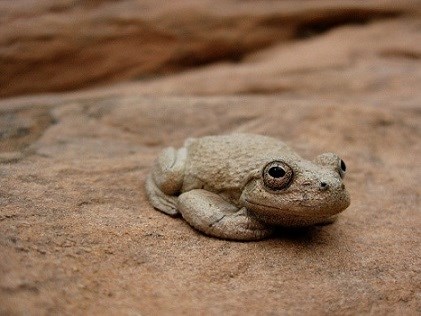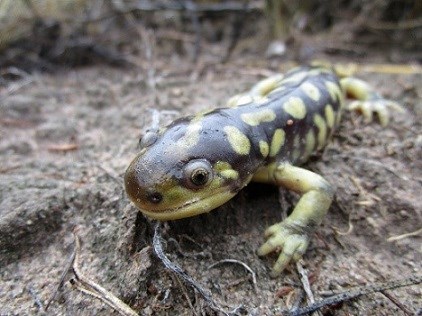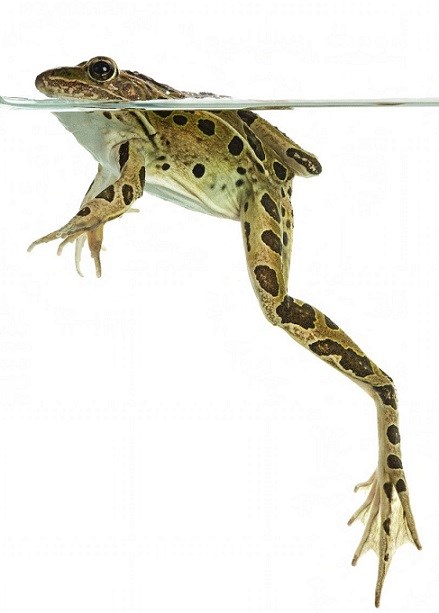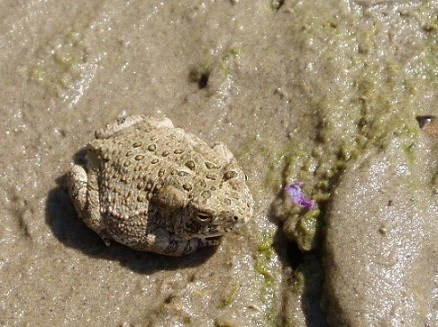Part of a series of articles titled NRCA 2022: Condition of Glen Canyon's Tributary Rivers and Associated Resources.
Article
Amphibians in the Desert
Many kids love frogs, and some even grow up to study them! One of the things that makes frogs, and other amphibians like toads and salamanders, so fascinating is that they have “double lives.” In fact, the word “amphibian” comes from a Greek word meaning “having two lives.” Amphibians have a larval stage and an adult stage that are often very different from one another. For example, a tadpole (larval stage) develops into a frog (adult stage).

NPS Photo
Almost all amphibians reproduce and develop in aquatic habitats, but adults of some species spend much of their time in drier environments. Although Lake Powell is one of the largest reservoirs in the U.S., not far from the lake shore is a very different and dry landscape. Amphibians, with their moist skin, must stay hydrated or they can die from desiccation. How difficult is it for amphibians to survive in the hot, arid environment that includes Glen Canyon National Recreation Area (NRA)?
What Threats do Amphibians Face?
Amphibians face a number of threats. These include disturbances, such as flooding, fire, debris flow, and grazing; loss of water resources; loss of connectivity of their habitat; and other factors, such as introduced plants, non-native bullfrogs and crayfish, predatory fish, and diseases. The threat of the loss of water resources is substantial, especially in arid environments like Glen Canyon NRA. 
NPS Photo
Amphibians as a Focus of Study at Glen Canyon
How are amphibians doing at the national recreation area today?A project known as a Natural Resource Condition Assessment (NRCA), overseen by the NPS NRCA Program of the NPS, was recently conducted to answer this and other questions at Glen Canyon NRA. NRCAs evaluate natural resource conditions so that parks can use the best available science to manage their resources. Amphibians, with an emphasis on the northern leopard frog, were one of a handful of focal resources selected for this project.
What Types of Amphibians occur at Glen Canyon NRA and Where do they Live?
|
|
|
|
|
|
|
Three other species may also occur in Glen Canyon NRA (American bullfrog [Lithobates catesbeiana], Great Plains toad [Anaxyrus cognatus], and plains spadefoot [Spea bombifrons]). All of these species are native to the U.S., but the American bullfrog was introduced to the western U.S. and is considered a non-native species at Glen Canyon. Bullfrogs pose a threat to native amphibians because they prey on and compete with native species.
In Glen Canyon NRA, amphibians breed in slow-moving side channels, isolated pools, springs, and tinajas. Non-breeding adults of all these species, except for the American bullfrog and northern leopard frog, aestivate (remain dormant during hot and dry conditions) underground, in rock crevices, or in other damp, dark places. Both the American bullfrog and northern leopard frog require water year-round. Amphibians have been confirmed at six of Glen Canyon NRA’s eight watersheds.
In Glen Canyon NRA, amphibians breed in slow-moving side channels, isolated pools, springs, and tinajas. Non-breeding adults of all these species, except for the American bullfrog and northern leopard frog, aestivate (remain dormant during hot and dry conditions) underground, in rock crevices, or in other damp, dark places. Both the American bullfrog and northern leopard frog require water year-round. Amphibians have been confirmed at six of Glen Canyon NRA’s eight watersheds.
A Focus on the Northern Leopard Frog at Glen Canyon NRA

US Fish and Wildlife Service/Sam Stukel
To study the northern leopard frog, ecologists at Utah State University gathered data on amphibian and frog occurrence (or occupancy), evidence of frog breeding and disease, and plant encroachment (wetland plant cover).
How Many Sites do Northern Leopard Frogs Inhabit in Glen Canyon NRA?
- Northern leopard frogs currently occur in 4 known sites in Glen Canyon NRA in the Escalante and Upper Lake Powell watersheds.
- Northern leopard frogs were found in a total of 29 locations in Glen Canyon NRA from the mid-1950s to 2019. At least 17 of these locations no longer have northern leopard frogs (many were flooded by Lake Powell).
- There are 8 locations where northern leopard frogs were found in the past, but current occurrence in the sites is unknown.
- Although northern leopard frog surveys were not systematic or widespread, it is clear there has been a substantial decline in occupied areas over the last 70 years.
Are Northern Leopard Frogs Reproducing in Glen Canyon NRA?
Fortunately, the answer is yes! The Arizona Game and Fish Department documented evidence of northern leopard frog breeding in the majority of occupied sites in any given year.
Are Northern Leopard Frogs Suffering from Disease at Glen Canyon NRA?
Northern leopard frogs (74) and a small number of other frogs (5) were tested for the fungus that causes chytridiomycosis (a serious amphibian disease). The samples were taken from 2007 to 2019 in four drainages in Glen Canyon NRA. None of the samples tested positive for the fungus.
Is Common Reed (Phragmites australis) Degrading Breeding Pools?
We need more information to answer this question. Common reed is an agressive plant that can reduce the amount of open water habitat in breeding pools. Our analysis showed a significant increase in wetland plant cover (385%) from 1995 to 2017 in some frog-occupied locations. However, it is unclear whether common reed or other vegetation is the main reason for the cover increase. What are the Next Steps for Amphibians at Glen Canyon NRA?
Because information on amphibians as a group is lacking, the recent NRCA made recommendations for future amphibian monitoring that would use four indicators—community composition and reproduction, water quality, non-native species, and disease.

NPS Photo
- Surveys at the eight sites where the status of the northern leopard frog is unknown.
- Additional monitoring of the potential loss of water resources in Glen Canyon NRA.
- Habitat surveys of known locations of the northern leopard frog to assess cover of plant species (such as Phragmites) that degrade northern leopard frog habitat.
- Continued/increased water quality monitoring, especially at breeding pools, for airborne or atmospheric contaminants (such as heavy metals or nitrogen fertilizers).
There is also a joint effort by NPS, Arizona Game and Fish Department, and Grand Canyon Wildlands Council underway to re-introduce northern leopard frogs at one location within Glen Canyon NRA. Breeding pools have been created and the re-introduction of frogs is planned for the near future.
|
|
|
|
|
Information in this article was summarized from: Albright J and Others. 2022. Natural resource conditions at Glen Canyon National Recreation Area: Findings & management considerations for selected resources. Natural Resource Report. NPS/SCPN/NRR—2022/2374. National Park Service. Fort Collins, Colorado. https://doi.org/10.36967/nrr-2293112
Last updated: July 14, 2022
